Jiahao Chang
MV-Performer: Taming Video Diffusion Model for Faithful and Synchronized Multi-view Performer Synthesis
Oct 08, 2025Abstract:Recent breakthroughs in video generation, powered by large-scale datasets and diffusion techniques, have shown that video diffusion models can function as implicit 4D novel view synthesizers. Nevertheless, current methods primarily concentrate on redirecting camera trajectory within the front view while struggling to generate 360-degree viewpoint changes. In this paper, we focus on human-centric subdomain and present MV-Performer, an innovative framework for creating synchronized novel view videos from monocular full-body captures. To achieve a 360-degree synthesis, we extensively leverage the MVHumanNet dataset and incorporate an informative condition signal. Specifically, we use the camera-dependent normal maps rendered from oriented partial point clouds, which effectively alleviate the ambiguity between seen and unseen observations. To maintain synchronization in the generated videos, we propose a multi-view human-centric video diffusion model that fuses information from the reference video, partial rendering, and different viewpoints. Additionally, we provide a robust inference procedure for in-the-wild video cases, which greatly mitigates the artifacts induced by imperfect monocular depth estimation. Extensive experiments on three datasets demonstrate our MV-Performer's state-of-the-art effectiveness and robustness, setting a strong model for human-centric 4D novel view synthesis.
Hi3DGen: High-fidelity 3D Geometry Generation from Images via Normal Bridging
Mar 31, 2025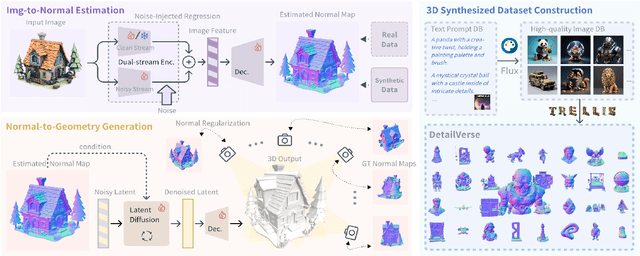
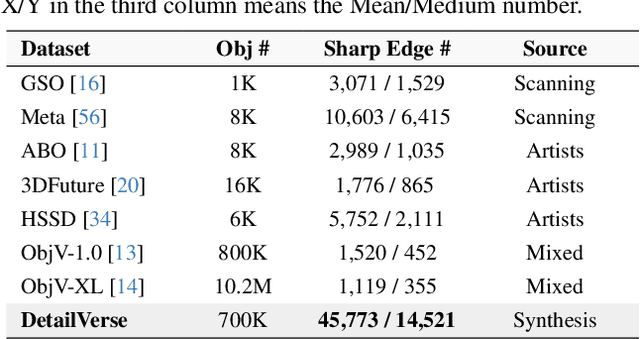
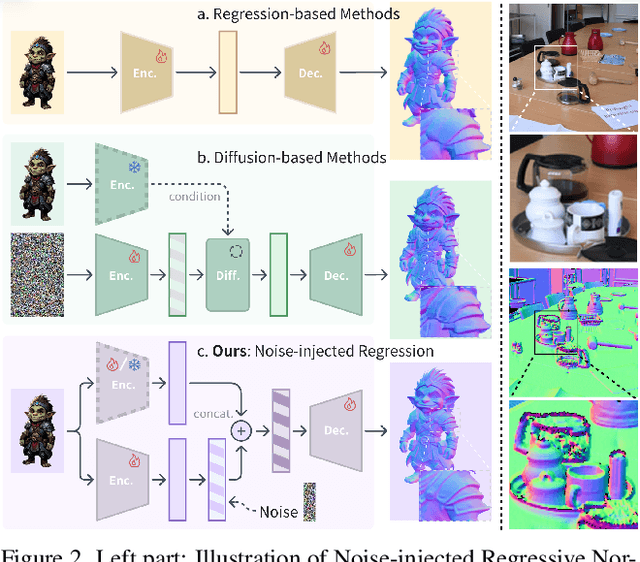
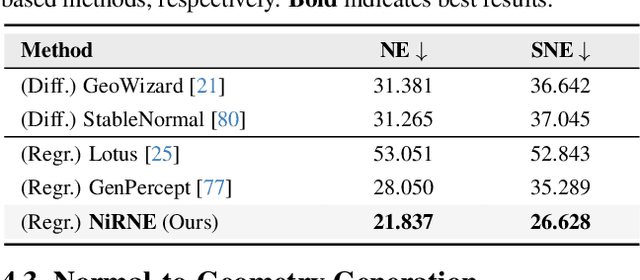
Abstract:With the growing demand for high-fidelity 3D models from 2D images, existing methods still face significant challenges in accurately reproducing fine-grained geometric details due to limitations in domain gaps and inherent ambiguities in RGB images. To address these issues, we propose Hi3DGen, a novel framework for generating high-fidelity 3D geometry from images via normal bridging. Hi3DGen consists of three key components: (1) an image-to-normal estimator that decouples the low-high frequency image pattern with noise injection and dual-stream training to achieve generalizable, stable, and sharp estimation; (2) a normal-to-geometry learning approach that uses normal-regularized latent diffusion learning to enhance 3D geometry generation fidelity; and (3) a 3D data synthesis pipeline that constructs a high-quality dataset to support training. Extensive experiments demonstrate the effectiveness and superiority of our framework in generating rich geometric details, outperforming state-of-the-art methods in terms of fidelity. Our work provides a new direction for high-fidelity 3D geometry generation from images by leveraging normal maps as an intermediate representation.
GaussReg: Fast 3D Registration with Gaussian Splatting
Jul 07, 2024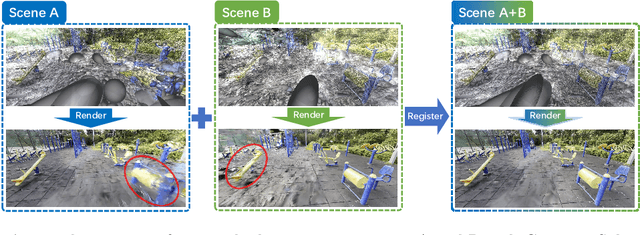



Abstract:Point cloud registration is a fundamental problem for large-scale 3D scene scanning and reconstruction. With the help of deep learning, registration methods have evolved significantly, reaching a nearly-mature stage. As the introduction of Neural Radiance Fields (NeRF), it has become the most popular 3D scene representation as its powerful view synthesis capabilities. Regarding NeRF representation, its registration is also required for large-scale scene reconstruction. However, this topic extremly lacks exploration. This is due to the inherent challenge to model the geometric relationship among two scenes with implicit representations. The existing methods usually convert the implicit representation to explicit representation for further registration. Most recently, Gaussian Splatting (GS) is introduced, employing explicit 3D Gaussian. This method significantly enhances rendering speed while maintaining high rendering quality. Given two scenes with explicit GS representations, in this work, we explore the 3D registration task between them. To this end, we propose GaussReg, a novel coarse-to-fine framework, both fast and accurate. The coarse stage follows existing point cloud registration methods and estimates a rough alignment for point clouds from GS. We further newly present an image-guided fine registration approach, which renders images from GS to provide more detailed geometric information for precise alignment. To support comprehensive evaluation, we carefully build a scene-level dataset called ScanNet-GSReg with 1379 scenes obtained from the ScanNet dataset and collect an in-the-wild dataset called GSReg. Experimental results demonstrate our method achieves state-of-the-art performance on multiple datasets. Our GaussReg is 44 times faster than HLoc (SuperPoint as the feature extractor and SuperGlue as the matcher) with comparable accuracy.
GauStudio: A Modular Framework for 3D Gaussian Splatting and Beyond
Mar 28, 2024Abstract:We present GauStudio, a novel modular framework for modeling 3D Gaussian Splatting (3DGS) to provide standardized, plug-and-play components for users to easily customize and implement a 3DGS pipeline. Supported by our framework, we propose a hybrid Gaussian representation with foreground and skyball background models. Experiments demonstrate this representation reduces artifacts in unbounded outdoor scenes and improves novel view synthesis. Finally, we propose Gaussian Splatting Surface Reconstruction (GauS), a novel render-then-fuse approach for high-fidelity mesh reconstruction from 3DGS inputs without fine-tuning. Overall, our GauStudio framework, hybrid representation, and GauS approach enhance 3DGS modeling and rendering capabilities, enabling higher-quality novel view synthesis and surface reconstruction.
TIFace: Improving Facial Reconstruction through Tensorial Radiance Fields and Implicit Surfaces
Dec 15, 2023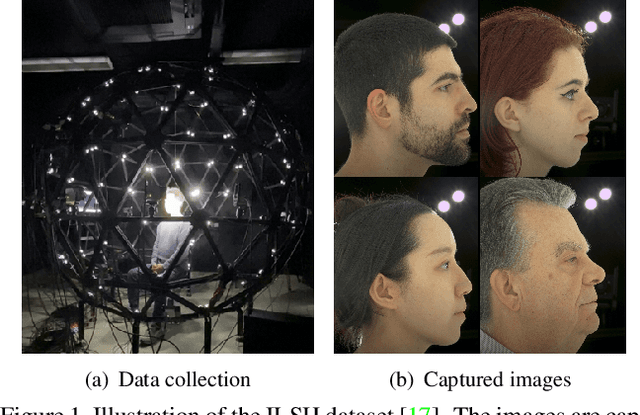
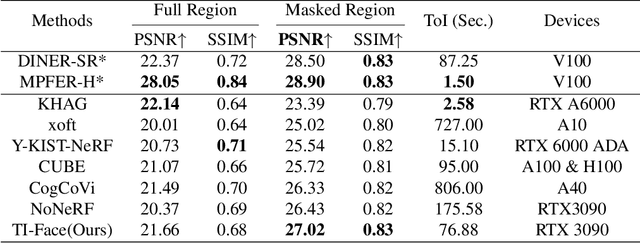
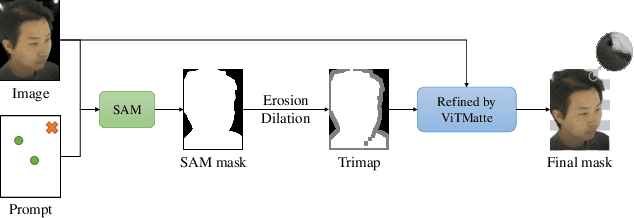
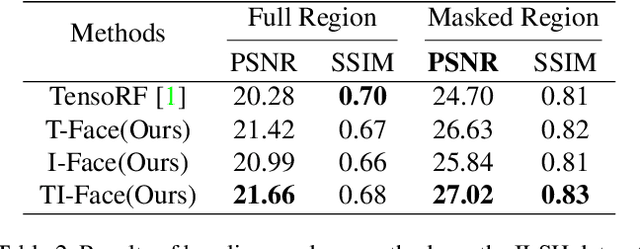
Abstract:This report describes the solution that secured the first place in the "View Synthesis Challenge for Human Heads (VSCHH)" at the ICCV 2023 workshop. Given the sparse view images of human heads, the objective of this challenge is to synthesize images from novel viewpoints. Due to the complexity of textures on the face and the impact of lighting, the baseline method TensoRF yields results with significant artifacts, seriously affecting facial reconstruction. To address this issue, we propose TI-Face, which improves facial reconstruction through tensorial radiance fields (T-Face) and implicit surfaces (I-Face), respectively. Specifically, we employ an SAM-based approach to obtain the foreground mask, thereby filtering out intense lighting in the background. Additionally, we design mask-based constraints and sparsity constraints to eliminate rendering artifacts effectively. The experimental results demonstrate the effectiveness of the proposed improvements and superior performance of our method on face reconstruction. The code will be available at https://github.com/RuijieZhu94/TI-Face.
TopoMLP: An Simple yet Strong Pipeline for Driving Topology Reasoning
Oct 10, 2023Abstract:Topology reasoning aims to comprehensively understand road scenes and present drivable routes in autonomous driving. It requires detecting road centerlines (lane) and traffic elements, further reasoning their topology relationship, i.e., lane-lane topology, and lane-traffic topology. In this work, we first present that the topology score relies heavily on detection performance on lane and traffic elements. Therefore, we introduce a powerful 3D lane detector and an improved 2D traffic element detector to extend the upper limit of topology performance. Further, we propose TopoMLP, a simple yet high-performance pipeline for driving topology reasoning. Based on the impressive detection performance, we develop two simple MLP-based heads for topology generation. TopoMLP achieves state-of-the-art performance on OpenLane-V2 benchmark, i.e., 41.2% OLS with ResNet-50 backbone. It is also the 1st solution for 1st OpenLane Topology in Autonomous Driving Challenge. We hope such simple and strong pipeline can provide some new insights to the community. Code is at https://github.com/wudongming97/TopoMLP.
The 1st-place Solution for CVPR 2023 OpenLane Topology in Autonomous Driving Challenge
Jun 16, 2023Abstract:We present the 1st-place solution of OpenLane Topology in Autonomous Driving Challenge. Considering that topology reasoning is based on centerline detection and traffic element detection, we develop a multi-stage framework for high performance. Specifically, the centerline is detected by the powerful PETRv2 detector and the popular YOLOv8 is employed to detect the traffic elements. Further, we design a simple yet effective MLP-based head for topology prediction. Our method achieves 55\% OLS on the OpenLaneV2 test set, surpassing the 2nd solution by 8 points.
Structured Epipolar Matcher for Local Feature Matching
Apr 13, 2023



Abstract:Local feature matching is challenging due to textureless and repetitive patterns. Existing methods focus on using appearance features and global interaction and matching, while the importance of geometry priors in local feature matching has not been fully exploited. Different from these methods, in this paper, we delve into the importance of geometry prior and propose Structured Epipolar Matcher (SEM) for local feature matching, which can leverage the geometric information in an iterative matching way. The proposed model enjoys several merits. First, our proposed Structured Feature Extractor can model the relative positional relationship between pixels and high-confidence anchor points. Second, our proposed Epipolar Attention and Matching can filter out irrelevant areas by utilizing the epipolar constraint. Extensive experimental results on five standard benchmarks demonstrate the superior performance of our SEM compared to state-of-the-art methods. Project page: https://sem2023.github.io.
Adaptive Spot-Guided Transformer for Consistent Local Feature Matching
Mar 29, 2023



Abstract:Local feature matching aims at finding correspondences between a pair of images. Although current detector-free methods leverage Transformer architecture to obtain an impressive performance, few works consider maintaining local consistency. Meanwhile, most methods struggle with large scale variations. To deal with the above issues, we propose Adaptive Spot-Guided Transformer (ASTR) for local feature matching, which jointly models the local consistency and scale variations in a unified coarse-to-fine architecture. The proposed ASTR enjoys several merits. First, we design a spot-guided aggregation module to avoid interfering with irrelevant areas during feature aggregation. Second, we design an adaptive scaling module to adjust the size of grids according to the calculated depth information at fine stage. Extensive experimental results on five standard benchmarks demonstrate that our ASTR performs favorably against state-of-the-art methods. Our code will be released on https://astr2023.github.io.
Towards Domain Generalization for Multi-view 3D Object Detection in Bird-Eye-View
Mar 03, 2023Abstract:Multi-view 3D object detection (MV3D-Det) in Bird-Eye-View (BEV) has drawn extensive attention due to its low cost and high efficiency. Although new algorithms for camera-only 3D object detection have been continuously proposed, most of them may risk drastic performance degradation when the domain of input images differs from that of training. In this paper, we first analyze the causes of the domain gap for the MV3D-Det task. Based on the covariate shift assumption, we find that the gap mainly attributes to the feature distribution of BEV, which is determined by the quality of both depth estimation and 2D image's feature representation. To acquire a robust depth prediction, we propose to decouple the depth estimation from the intrinsic parameters of the camera (i.e. the focal length) through converting the prediction of metric depth to that of scale-invariant depth and perform dynamic perspective augmentation to increase the diversity of the extrinsic parameters (i.e. the camera poses) by utilizing homography. Moreover, we modify the focal length values to create multiple pseudo-domains and construct an adversarial training loss to encourage the feature representation to be more domain-agnostic. Without bells and whistles, our approach, namely DG-BEV, successfully alleviates the performance drop on the unseen target domain without impairing the accuracy of the source domain. Extensive experiments on various public datasets, including Waymo, nuScenes, and Lyft, demonstrate the generalization and effectiveness of our approach. To the best of our knowledge, this is the first systematic study to explore a domain generalization method for MV3D-Det.
 Add to Chrome
Add to Chrome Add to Firefox
Add to Firefox Add to Edge
Add to Edge